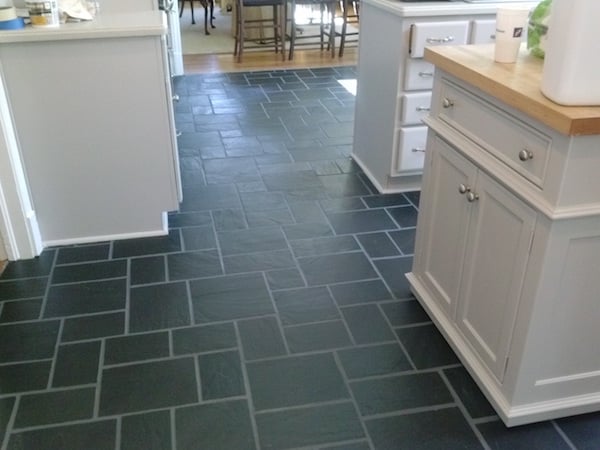
What makes a slate floor so great? Why have they become a popular trend in home improvement? Well, think about how they’re made. That’s right. Though not manmade, even natural stone is constructed on some level. It’s a metamorphic rock, which means that it’s created by melding several elements, such as calcite and quartz, together to form a new material. These elements are compressed by the earth and subjected to extreme heat, and in the end, slate is produced. This process makes the stone tremendously hard and almost indestructible, which also makes it an excellent material for floors.
Change-Resistant
During the formulation of the stone, a lot of transformations take place in terms of geological composition. But once complete, this rock doesn’t change. It’s tough and durable (as long as it’s not abused), almost completely stain resistant (as long as it’s properly sealed), and it’s very long lasting. Think about where it usually lives in nature: lining the beds of raging rivers. So slate flooring definitely has the endurance to hold up against foot traffic, and it can be installed anywhere, both interior and exterior. Due to its texture, it can hold up against water; so it can be put in bathrooms, kitchens, and showers. It’s originally born outside, so it can be used on walkways, garden stone, and patios. Plus, it’s fireproof, easy to maintain, and can usually conceal any dirt it may collect.
Diversity, Variety, and Neutrality
The best thing about slate floors is their shear multiplicity. They have a unique, modern look about them, yet can also feel rustic and old-fashioned. Plus, they come in a diverse range of colors, textures, shapes, and sizes, allowing them to fit in with any room, design style, or piece of furniture. Here are some various ways slate flooring gives you options:
- Color: Because it’s an amalgam of different earthly elements, it can come in green, white, and even purple. But since it’s such an organic material, many homeowners prefer neutral tones: black, gray, and brown.
- Texture: It can be a little rough to the feet, providing a natural traction. But it can also be honed or sanded, giving the rock a slick sheen. Or it can be polished with a high-gloss, though this makes it slippery when wet and may damage its original look in the long run.
- Shape and Size: It comes in different dimensions and shapes, allowing for interesting design patterns. Plus, it comes in varying thicknesses depending upon your needs.
Ready to start your slate floor?
Find ProsSlate Flooring: The Best of Both Worlds
Slate floors come with flaws, but even these failings can be resolved with some imaginative renovation. First off, before you install, you may want to consider value. Will this installation be an asset or shortcoming to your house? All natural stone is tricky: it adds value in terms of a unique look, strength, and luxury. But it’s also a very specific taste and a pretty permanent installation, so it may turn some buyers off. But ultimately it’s your house and you have to live there. So no matter what, always do what you want.
- Expense: All natural stone is a bit expensive, but slate floors are the perfect middleman. Running at about $2-6 per a square foot (depending on the quality, style, and size), it costs more than porcelain and ceramic tiles but a lot less than marble or granite.
- Sealant: If you don’t seal it once in awhile, it remains vulnerable to stains. But polishing it involves constant reapplication, and doing that too much can create a waxy buildup. So a coat of sealer every year is the only obligation it really requires.
- Maintenance: It’s easy to clean with simple soap and water. But it’s also installed with grout, which will have to be scoured occasionally.
- Cold vs. Warm: Like all natural stone, it can sometimes feel a bit cold. In the winter it’s chilly to the touch (though in the summer it’s a natural coolant), it can possibly produce an echo, and it can simply look a bit harsh. Therefore, use it sparingly, possibly in smaller rooms, and put down rugs to warm things up and absorb the sounds.
 Concrete Flooring – Solid as a Rock
Concrete Flooring – Solid as a Rock  Cleaning Hardwood Floors
Cleaning Hardwood Floors  Carpet Cleaning Methods 101
Carpet Cleaning Methods 101  The Benefits of Laminate Flooring
The Benefits of Laminate Flooring  Flooring Ideas for Your Home Gym
Flooring Ideas for Your Home Gym 

Are You Familiar With This Topic? Share Your Experience.